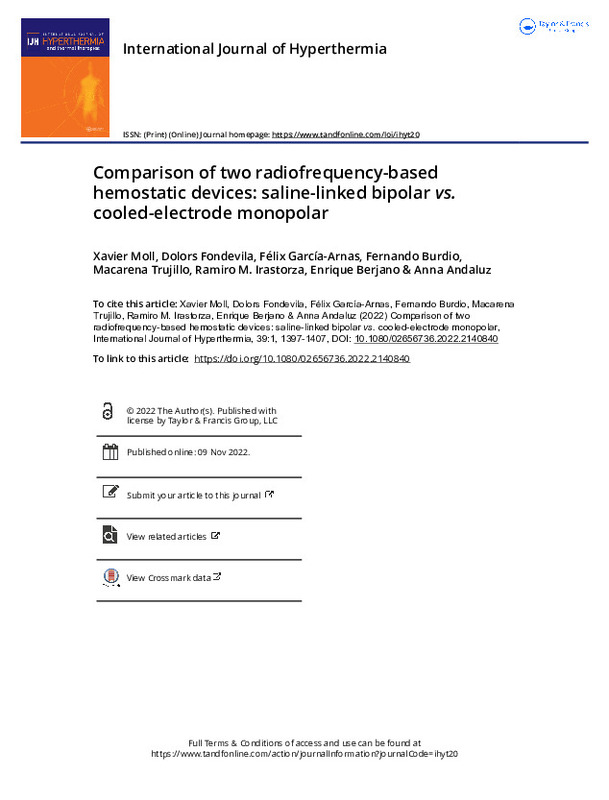JavaScript is disabled for your browser. Some features of this site may not work without it.
Buscar en RiuNet
Listar
Mi cuenta
Estadísticas
Ayuda RiuNet
Admin. UPV
Comparison of two radiofrequency-based hemostatic devices: saline-linked bipolar vs. cooled-electrode monopolar
Mostrar el registro sencillo del ítem
Ficheros en el ítem
| dc.contributor.author | Moll, Xavier
|
es_ES |
| dc.contributor.author | Fondevila, Dolors
|
es_ES |
| dc.contributor.author | García-Arnás, Félix
|
es_ES |
| dc.contributor.author | Burdio, Fernando
|
es_ES |
| dc.contributor.author | Trujillo Guillen, Macarena
|
es_ES |
| dc.contributor.author | Irastorza, Ramiro M.
|
es_ES |
| dc.contributor.author | Berjano, Enrique
|
es_ES |
| dc.contributor.author | Andaluz, Anna
|
es_ES |
| dc.date.accessioned | 2022-11-25T19:02:14Z | |
| dc.date.available | 2022-11-25T19:02:14Z | |
| dc.date.issued | 2022-12-31 | es_ES |
| dc.identifier.issn | 0265-6736 | es_ES |
| dc.identifier.uri | http://hdl.handle.net/10251/190211 | |
| dc.description.abstract | [EN] Purpose To characterize the coagulation zones created by two radiofrequency (RF)-based hemostatic devices: one comprised an internally cooled monopolar electrode and the other comprised externally irrigated bipolar electrodes (saline-linked). Materials and methods RF-induced coagulation zones were created on ex vivo and in vivo porcine models. Computer modeling was used to determine the RF power distribution in the saline-linked device. Results Both external (irrigation) and internal cooling effectively prevented tissue sticking. Under ex vivo conditions in 'painting' application mode, coagulation depth increased with the applied power: 2.8 - 5.6 mm with the 3-mm monopolar electrode, 1.6 - 6.0 mm with the 5-mm monopolar electrode and 0.6 - 3.2 mm with the saline-linked bipolar electrodes. Under in vivo conditions and using spot applications, the 3-mm monopolar electrode created coagulation zones of similar depth to the saline-linked bipolar electrodes (around 3 mm), while the 5-mm monopolar electrode created deeper coagulations (4.5 - 6 mm) with less incidence of popping. The presence of saline around the saline-linked bipolar electrodes meant that a significant percentage of RF power (50 - 80%) was dissipated by heating in the saline layer. Coagulation zones were histologically similar for all the tested devices. Conclusions Both external (irrigation) and internal cooling in hemostatic RF devices effectively prevent tissue sticking and create similar coagulation zones from a histological point of view. Overall, saline-linked bipolar electrodes tend to create shallower coagulations than those created with an internally cooled monopolar electrode. | es_ES |
| dc.description.sponsorship | Spanish Ministerio de Ciencia, Innovacion y Universidades MCIN/AEI/10.13039/501100011033 [Grants RTI2018-094357-B-C21 and RTI2018094357-B-C22], "Agencia Nacional de Promocion Cientifica y Tecnologica de Argentina" [PICT-2020-SERIEA-00457], Dr. Irastorza was the recipient of a scholarship from the Programa de Becas Externas Postdoctorales para Jovenes Investigadores del CONICET (Argentina). | es_ES |
| dc.language | Inglés | es_ES |
| dc.publisher | Taylor & Francis | es_ES |
| dc.relation.ispartof | International Journal of Hyperthermia | es_ES |
| dc.rights | Reconocimiento (by) | es_ES |
| dc.subject | Cooled electrode | es_ES |
| dc.subject | Hemostatic device | es_ES |
| dc.subject | Radiofrequency | es_ES |
| dc.subject | Salinelinked | es_ES |
| dc.subject | Thermal ablation | es_ES |
| dc.subject.classification | MATEMATICA APLICADA | es_ES |
| dc.subject.classification | TECNOLOGIA ELECTRONICA | es_ES |
| dc.title | Comparison of two radiofrequency-based hemostatic devices: saline-linked bipolar vs. cooled-electrode monopolar | es_ES |
| dc.type | Artículo | es_ES |
| dc.identifier.doi | 10.1080/02656736.2022.2140840 | es_ES |
| dc.relation.projectID | info:eu-repo/grantAgreement/AEI/Plan Estatal de Investigación Científica y Técnica y de Innovación 2017-2020/RTI2018-094357-B-C21/ES/MODELADO Y EXPERIMENTACION PARA TERAPIAS ABLATIVAS INNOVADORAS/ | es_ES |
| dc.relation.projectID | info:eu-repo/grantAgreement/ANPCyT//PICT-2020-SERIEA-00457/ | es_ES |
| dc.relation.projectID | info:eu-repo/grantAgreement/AEI/Plan Estatal de Investigación Científica y Técnica y de Innovación 2017-2020/RTI2018-094357-B-C22/ES/INVESTIGACION QUIRURGICA PARA TERAPIAS ABLATIVAS INNOVADORAS/ | es_ES |
| dc.rights.accessRights | Abierto | es_ES |
| dc.contributor.affiliation | Universitat Politècnica de València. Escuela Técnica Superior de Arquitectura - Escola Tècnica Superior d'Arquitectura | es_ES |
| dc.contributor.affiliation | Universitat Politècnica de València. Escuela Técnica Superior de Ingeniería del Diseño - Escola Tècnica Superior d'Enginyeria del Disseny | es_ES |
| dc.description.bibliographicCitation | Moll, X.; Fondevila, D.; García-Arnás, F.; Burdio, F.; Trujillo Guillen, M.; Irastorza, RM.; Berjano, E.... (2022). Comparison of two radiofrequency-based hemostatic devices: saline-linked bipolar vs. cooled-electrode monopolar. International Journal of Hyperthermia. 39(1):1397-1407. https://doi.org/10.1080/02656736.2022.2140840 | es_ES |
| dc.description.accrualMethod | S | es_ES |
| dc.relation.publisherversion | https://doi.org/10.1080/02656736.2022.2140840 | es_ES |
| dc.description.upvformatpinicio | 1397 | es_ES |
| dc.description.upvformatpfin | 1407 | es_ES |
| dc.type.version | info:eu-repo/semantics/publishedVersion | es_ES |
| dc.description.volume | 39 | es_ES |
| dc.description.issue | 1 | es_ES |
| dc.identifier.pmid | 36351216 | es_ES |
| dc.relation.pasarela | S\476467 | es_ES |
| dc.contributor.funder | AGENCIA ESTATAL DE INVESTIGACION | es_ES |
| dc.contributor.funder | Agencia Estatal de Investigación | es_ES |
| dc.contributor.funder | Agencia Nacional de Promoción Científica y Tecnológica, Argentina | es_ES |
| dc.contributor.funder | Consejo Nacional de Investigaciones Científicas y Técnicas, Argentina | es_ES |
| dc.subject.ods | 03.- Garantizar una vida saludable y promover el bienestar para todos y todas en todas las edades | es_ES |








